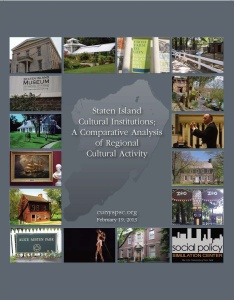Papers – Economy
Staten Island Cultural Institutions A Comparative Analysis of Regional Cultural Activity
– February 2013
The report uses the rich survey data of cultural institutions generated from the Cultural Data Project to analyze the activities and performance of Staten Island’s 28 reporting institutions. In addition, we augment our analysis with data from the Bureau of Labor Statistics on employment in the creative sectors in New York City. Comparisons are drawn between Staten Island’s cultural institutions and those in the other boroughs. The report employs the data to analyze cultural institutions within the context of economic development policy, and efforts to extend the reach of the cultural institutions to wider audiences on Staten Island and beyond.
The Shareholder Wealth Implications of Strike size and Duration, J. Kramer and J. Peters
Journal of the Northeastern Association of Business, Economics and Technology—Fall 2008
Previous studies have found that strikes, on average, have a negative impact on shareholder wealth. This study confirms those findings, and extends them by using data from individual strikes to measure the relationship between strike size and duration, and changes in the market value of the struck firm. The authors find that, while statistics on strike size and duration are widely disseminated, they have little informational value with respect to gauging the shareholder wealth effects of a strike. This finding weakens the case of those who argue in favor of outside intervention in very large and/or lengthy strikes.
Kelley School of Business, Indiana University – 2008
The U.S. Customs and Border Protection reports that counterfeit goods seizures were up 83% in 2006. While a plethora of anti-counterfeiting strategies target distribution channels, international organizations, pirates, and company-based initiatives, few reports debate the effectiveness of these distinct anti-counterfeiting tactics to curb the problem. For this study we conducted in-depth interviews with United States managers to gauge the efficacy of various anti-counterfeiting tactics to preserve intellectual property rights. The results indicate that corporate managers find the practice of encouraging distributors to notify the manufacturer about counterfeits, as well as educating both employees and channel members about the counterfeit problem, to be some of the most effective ways to fight pirates. However, the managers report many other tactics are futile, including providing financial incentives for distributors to reject counterfeits and stressing the harmful effects of fake goods in advertising. We recommend a specific program that firms can employ to deter counterfeiting, including managing the registration of all trademarks and patents in key markets, establishing a company-based enforcement team, monitoring the growth of fakes through a central information repository, developing a muti-pronged action plan, and preparing to fight pirates through investigative work in conjunction with local law enforcement.
Journal of Applied Finance – 2001

